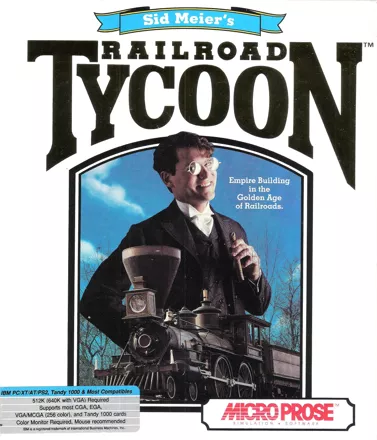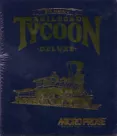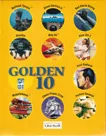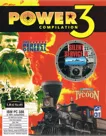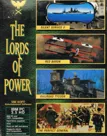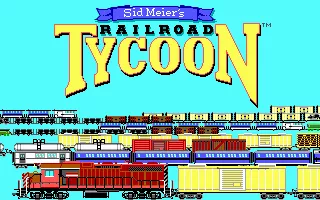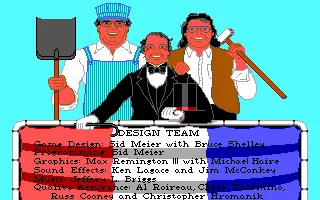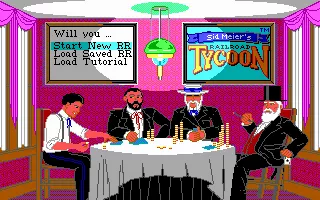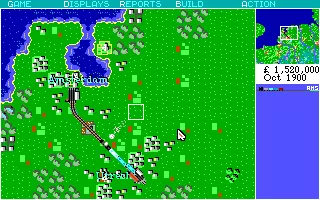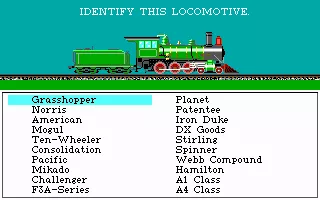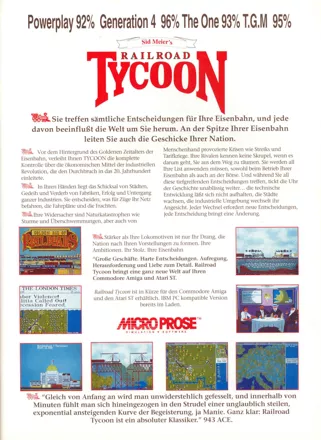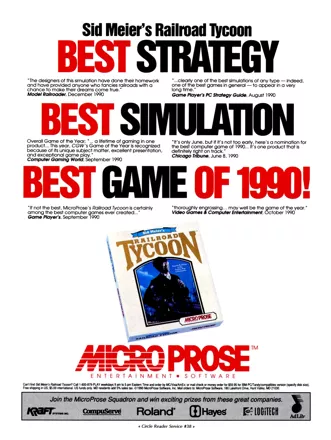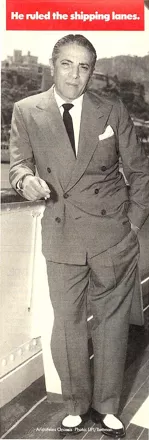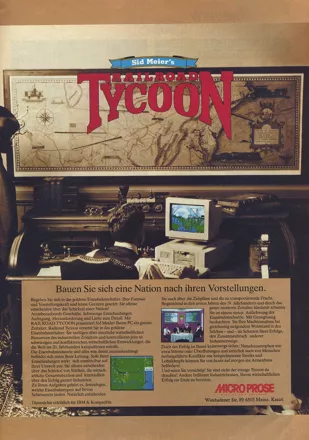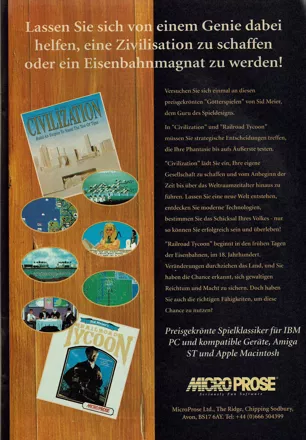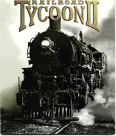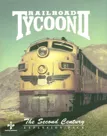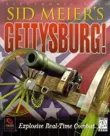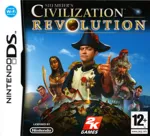Sid Meier's Railroad Tycoon
Description official description
With $100000 in the bank after taking out loans and selling stocks, it's time to start a railroad! Choose from 4 scenarios across two continents with randomly generated resources, and design your own railroad that moves people and goods across the country. Use the revenue to continue expanding, while keeping control of your company and appeasing your stock holders with growth and revenues. Play the stock market with company assets. Drive your competitors out of business with buyouts and rate wars. Multiple types of resources to carry (roughly grouped as slow freight, fast freight, passengers, mail) and convert, own facilities to maximize profit (buy a steel mill and the conversion from iron ore to steel makes money for YOU). Use the latest available technology to your advantage (new locomotives). Your objective is to retire with a huge bonus (based on your company's assets) and become the President or the Prime Minister (depending on which continent).
The game is essentially a bird's-eye-view real-time strategy game with aspects of building and stock market manipulation. Each fiscal period is 2-years, which corresponds to 1-day of track time. Build different sizes of stations to take care of different local needs, create trains that switch consists at different stations and maximize throughput. Upgrade/retire/modify trains as times change. The faster the trains arrive, the more money they earn. Multiple options will keep you busy as each game is different.
Spellings
- Sid Meier's レイルロードタイクーン - Japanese spelling
- 铁路大亨 - Simplified Chinese spelling
Groups +
Screenshots
Promos
Credits (DOS version)
23 People · View all
| Original Concept | |
| Design | |
| Programming | |
| Graphics | |
| Music / Sound Programming | |
| Music Composition | |
| Quality Assurance | |
| Manual text | |
| Direction & Design | |
| Technical Illustrations | |
| Screen Shot Illustrations | |
| Pen & Ink Illustrations | |
| Layout | |
| [ full credits ] | |
Reviews
Critics
Average score: 89% (based on 30 ratings)
Players
Average score: 4.0 out of 5 (based on 83 ratings with 5 reviews)
Fun and highly addictive with lots of replay value
The Good
Freedom of action - once the basic features of a scenario are set (random resource locations, player-chosen difficulty level), it's all up to you as a player to decide what to do - which cities to connect, what locomotives and cars to use, what cargos to carry, when to borrow and pay back loans, when to buy and sell stock, on and on.
Building something - it's like a construction set or model railroad. It's satisfying to start off small, have it work and then make it bigger.
Replayability - once a scenario (100 years of game time) is finished, the immediate question is "could I do better?". And it's always fun to try. The random resource locations make each scenario sufficiently different that it really does feel like a new game (so you can't simply make the same decisions you did before), but not so different that you can't use general techniques you've picked up.
The Bad
Copy protection - when the game first loads it shows a picture of a locomotive and asks for its name. All the pictures and names are shown together in the manual, so you have to have the manual (so presumably you have a legal copy). But come on, it's over ten years later. The game hasn't been in stores for years. The company isn't making any revenue off of it in any case. Why do we still have to deal with this?
The limitation of 32 - you can have at most 32 trains running at one time (but I want more!). You can have at most 32 stations on one railroad (but I want more!). Once you reach these limits you can't make your railroad any bigger. Past this point the only way to increase your wealth (ie., your score) is to play the stock market. In one sense that's the most effective way to run up your score, since as time goes by the stock market valuation of your railroad can exceed its yearly operating revenue by quite a large margin. But after several years (real ones, not game ones) I ran into the final limitation of 32 - a railroad can have a maximum value of a little over $32 million (probably $32,768,000). Past that point the value is interpreted as a negative value, and the game abruptly declares that your railroad is bankrupt and you have "lost". And that is pretty much the only reason why I've stopped playing it - the "can I do better?" question has definitively been answered "No".
The Bottom Line
A game for people who like to plan and build things, who enjoy watching something grow and prosper strictly because of their own efforts. Not for those with short attention spans.
There are built-in limitations in the game (including one outright bug), but most players will never reach them without the performance improvement that comes only from long and repeated experience with it.
DOS · by anton treuenfels (34) · 2001
Great resource management and historical game
The Good
Stock Market Trading, Shares, Take Overs, History, Train Types
Review: Railroad Tycoon, or Railway Tycoon as we should really call it in Britain was Microprose's first blockbuster game. They had been around for about 10 Years before it came out, and to quote Michael Caine 'Not a lot of people know that'. I've played this game so many times I know nearly all the Engines in the start up password quiz by heart. They seem to have started designing it as a glorified computer train set, with track, moving engines, rolling stock, and signals. Then half way through they decided to add a resource management feature as well. It has a complicated 'No Collision Operation' option, which you can turn off for a 10% penalty on your score, which I do, as I find it very tiresome and irritating. Basically this involves putting dozens of signal boxes along your track, which means you can't build branch lines exactly where you would like, and that your trains are for ever waiting. In this game time IS money, so delay costs.
There are four continents you can play on: Eastern USA (begins 1830), Western USA (begins 1866), England (begins 1828), and Europe (begins 1900). Each continent has 11 possible resources that can be shipped between Stations, for which you get payment on arrival. Revenues reduce with time taken, and game year i.e. Railroads become less and less profitable over the years. But new trains come out regularly that increase speed, and the number of carriages each train can have. Resources vary according to continent, some are in every continent, others only in one, and some can be taken to resource specific Factories to be converted into another resource that can be shipped on, for more profit. In you have a lot of a resource, but no Factory to send it to, you can buy one usually, if a site can be found by one of your Stations, Textile Mills are the most difficult as they have to be built by hills for water-power. It will cost a lot of money, you may have to borrow some, but once built, you get a share of the profits from the Factory, plus money for taking raw materials there, and processed stuff away, or to Cities and Ports. The more stuff you send Cities the faster they grow. Be aware the Factory may change to another product, which you might already have on your line, or go bankrupt and disappear if you don't give it enough business. Priority Shipments come along from time to time, they make you a lot of money, but mean you have to re-route your network to get them.
My favourite continent is Eastern USA, as you start at the beginning of Railroad history, with really slow Engines. The Steam Train had just been invented in England, and thanks to a common language the technology quickly reached America. The Hudson-Erie Canal had just been opened (in 1825) linking the Factories of New York to the resources of the Great Lakes region. Niagara Falls previously prevented ships going beyond the first Lake, Ontario. This threatened Baltimore another Atlantic Port with competition, as it's hinterland included the Ohio River, close to the Great Lakes. A canal was impractical so they decided to try the new fangled Steam Engine Technology, to haul Coal, Grain, and Lumber from the Interior to the Port, for processing or onward shipment. They also discovered that Mail and Passengers could be shipped both ways for a profit, remember this is a time when immigrants were heading West, and roads were of very poor quality. Also manufactured goods could be shipped back to the less developed interior.
The main gripe with this game option is that you can't load a historically accurate map, instead getting a different computer generated map each time. So although the larger Cities are generally in the East, you find some mega cities, that aren't even on the coast, and Cities like New York look like Villages. I have lost count of the times I tried to make New York into a City, economically difficult, as you have to buy a very expensive bridge to link it to another City, and if it is too small it won't accept most goods. I tried to build the Baltimore and Ohio Railroad, but never got beyond Harpers Ferry, Hagerstown, and the Cumberland Gap, as it got so annoying, shipping stuff from Stations even though they demanded it, which also clogged up my line. The rivers on the Map have landing facilities which is good, because you can dispose of Grain and Coal, even if you don't have Steel Mills, Food Processing Plants, and Ports, this also applies to the Western American continent.
The Western American continent has some interest, as you get twice as much for West-East Trade, and half for North-South (until the building of a Transcontinental Railroad when the rates equal), making route design more important and tricky, you also have to bridge the rocky mountain chain. The game doesn't also double track tunnels which is a real a pain, I would happily pay double for them). It is set in the time when the U.S. Government is trying to link the Mississippi/Great Lakes to the Pacific by Rail, the first company to do it gets a $1,000,000 bonus, but your so rich by then you don't need it. It would have been good if they could have it so you could start building from the East, and West, joining in the middle, as historically happened with Chinese being shipped over to build the Western Line, and for one Company the last track pin linking the two lines being made of Gold. You get to build through towns like Dodge City and Junction City.
England is OK, but there are just too many big cities, and resources scattered everywhere. Much easier to connect everything using the Infernal Combustion Engine, this is the weakness of Railways they are good at bulk transport, and connecting Big Cities and Resource Sites, but hopeless at linking lots of little sites together. Today only about 7% of freight goes by Rail, so people who think it is the answer to Pollution and Congestion are dreaming, although it can help a bit, but requires massive subsidies. You do however get a good variety of stuff arriving in your Ports in this option.
I don't like the European Continent at all, you have farms which provide Nitrates and Wool, meaning you have to find the City to take both resources simultaneously or routing becomes a Nightmare, and I don't like shoveling poo, even of the computer variety. Also Arms, the last commodity in a 3 stage production chain, can only be disposed of at Ports, and Forts which are in out of the way places, which usually means an extra Station.
Stations collect resources, they come in three sizes with increasing cost, and their hinterlands can not overlap. You can build improvements in them like Hotels and Restaurants to generate extra income, but have a maintenance, and will not make much if you don't have enough traffic. Improvements like Post Offices, Cold Stores, Goods Sheds, and Livestock Pens prevent potential traffic disappearing before you trains arrive, you still lose money because they are waiting though. Engine Shops allow new trains to be built and maintained, which reduces Train Maintenance costs, which increase over time, sometimes it is a good idea to retire an Engine and replace it with a new one, or better model.
Track is built from one Station to another, select the route carefully, as curves and hills slow Trains and reduce revenue. You also have to pay for most land, the price depending on type, Woods are free, Farms cheap, and Cities expensive. Track can be single or double, single is cheaper to build and maintain but slower for more than one train, it depends on you finances and traffic quantity and type which you choose. Bridges can be built over rivers, single track ones are cheap, but only allow one Train past at a time, the others having to wait, also they might get washed out which screws up your schedule, may means you lose a Train, and delays all the others until it is repaired. Double Track Bridges are expensive, but much faster and safer, in later years technology makes them cheaper. You can also build over Ocean squares by using permanently secured ships, I seldom bother with this as it seems unrealistic.
There is a Financial side to the game which is most enjoyable. You start of with 500,000 shares that you sold to local investors at $1 each, giving you $500,000 starting capital, you have also borrowed one $500,000 bond from the bank, for which to pay an annual interest rate, until you decide to pay it back. Bonds charge less interest than overdrafts so if you run up a big debt, it's good to use them. The interest varies depending on the economic climate (Boom, Prosperity, Normal, Recession, and Panic), how many bonds you already have, and how many times you have declared bankruptcy, once the rate reaches a certain amount you can't borrow anymore. Basically the more debt you have, the more you pay. Beware of bonds if you have too many you interest payments will exceed you earning, and your company will go bust. When the economic climate improves, you can refinance bonds at a cost of $10,000 brokerage fee, which will reduce the interest charged. Don't buy bonds unless you have something good to spend the money on, like adding a new City to your line, or buying your own shares to prevent the company getting taken over. If the interest becomes too bad you can declare bankruptcy, this halves your debt but you can't build new track until you have repaid the other half of the debt. I don't like doing this, as it means your original shareholders lose everything, the shares going to your creditors, but sometimes it is better than the company going out of business all together. Also you will lose all your own company shares, which means another Railroad can buy them and take you over, once taken over you're out of the game. You can turn this option off, but I find it fun. You can also take over other Railroads, take their money, repay their debts, order them to build lines, or connect your Line to theirs. If you don't manage them well they can go out of business. The number you can take over depends on difficulty, the higher the difficulty the more you can manage, also the more likely you are to be taken over, and the lower your revenues. There are a lot of useful reports that help you financially manage your company, plus history and efficiency reports, and a history of your share price.
A fun thing is when you build into some Cities they offer to buy 10,000 new company shares at the current price, this means you get a pile of money to help finance the expansion, but it's a bit of a gamble as they don't offer that often so you may over stretch yourself, and once the share price exceeds a certain amount they don't buy at all, which I find stupid, surely they could just buy less. Also your share price will be depressed, and you will not own these new shares, so it may mean a competitor can once again try to take you over. Once you hold 50% of the stock you can't be taken over, but the price goes up each time you buy a block of shares, and down when you sell. If shares perform badly over a long period the Shareholders will vote you out of office, and find a new RR President, thus ending the game. When this happens you are shown a funny scene of the President operating one of those up/down hand operated track inspection cars, leaving the Station in his Top Hat.
Rate Wars also occur, this is when two rival companies build track into the same City. The town council votes depending on how much trade each line brings. During the War your revenue for that Station is halved, for two years after you Win (if you Win) it's Doubled! The loser can never build there again.
The game has a number of problems which really got my goat. Say you ship Coal to a Station which can convert it to Steel, this same Station can also take Steel and convert it to Manufactured Goods BUT you can't take Coal, and end up with Manufactured Goods, you have to take it somewhere else, ridiculous!!! This also applies to Factories piling up goods which the same City demands. 100% conversion isn't very realistic either, and you should require Coal AND Iron to make steel. Also Ports provide goods, and you can earn money, shipping stuff from one Port to another, even though it is also available there, surely it would just be shipped direct. The core problem is that every City has an infinite demand for any commodity once it has a Port, Factory, or enough Village/City Blocks. This also applies to Passengers, everyone wants to get on the first train no matter where it's going, and at the first stop they all get off again. They should have several types of Passenger, Local, Regional, and Intercontinental. Of course limited demand would be difficult to simulate and manage, but well worth it, perhaps Railroad Tycoon II does this, I haven't tried it yet.
Also you should be able to buy double track tunnel, as otherwise I find you always have to build over Hills, as only one train can use a tunnel at a time, the others have to wait. It would be OK if you had to wait a bit for the technology to become available. Quadruple track would also be good, so you could have fast lines for Passenger Engines, and slow lines for Freight Engines, without either having to wait due to different speeds. If you have two Cities I tend to have two trains, one starting in each simultaneously, carrying the same goods - what would be good is if they were always half apart, but what happens is that one gets overloaded, and the other follows just behind virtually empty, as the other train has picking up everything, meaning you don't get the benefit of speedy pickup and fast delivery.
Another problem is that if you build your Station in the centre of a City, you tend to get a resource field on the edge, only half of which you can cover. A better way would be to have each Station collect specific resources, so you could have one Passenger/Mail/Factory Station, and another close overlapping Coal/Lumber/Grain Station which could pick up everything in one Train.
They should have more than 3 competing Railroads, 8 or 10 in total would be about right. As what happens is one becomes super big and takes all the Cities, cutting off large areas to competition as Railroads, can't cross over competitors tracks. This would make for more interesting stock-market competition, and more Rate Wars.
To conclude this was one of my favourite games, I have now played it to
death. The trouble is once you get beyond two main Stations it gets very
annoying for the above reasons, so I usually give up as I get so
frustrated by the inaccuracies.
The Bad
Big Cities not in East is Eastern USA Scenario, no Historically accurate Maps, can’t double convert goods i.e. coal->steel->goods when steel works and factory in city radius, should have commodities only stations so overlapping stations can center on resources, should have radius 4 station by building mass transit in Terminal, and should have double track tunnels at twice the cost.
The Bottom Line
Lots of game play. A classic. Helped make Microprose's name.
Amiga · by David Ledgard (58) · 2005
This game cost me *years* of my free time!
The Good
Where to begin...
This game is a jewel, and you really only begin to appreciate its depth at the higher difficulty levels. On the higher difficulty levels, you have to manage a complex economy. For example a city will only pay you to deliver hops if there happens to be a brewery within the city limits.
Or, you could build a brewery in the city, if you had a large source of hops nearby, waiting to be exploited... but that'll cost you a lot of cash up front. Decisions, decisions. And of course, ANY old city will pay for the beer that you deliver, right? It's so wonderful, taking coal to one city to make steel, delivering the steel to yet another city to make manufactured goods, then delivering the goods to a third city for the final money-making run.
Then there's the constant concern about purchasing back enough of your company stock that the other tycoons don't get majority shareholder status of your company and run you out of town.
Then too, you have to worry about them tying their railroads into your cities and starting a fare war. You lose a major economic engine if you lose a major city, and then you are sunk!
There is incredible replayability to this game because although the maps are the same, the size of the cities and placement of minor impediments to building tracks vary. The stock market goes up and down like a yo-yo, forcing you to make economic decisions about borrowing money and paying off debt.
There are four starting scenarios: England, the first trains, Europe, pre WW I, Easter US with the first trains, and the Western US Post civil War. Each requires a different strategy to succeed, and strategies that work well in the opening game begin to fail in the mid game and are liabilities at the end-game.
The Bad
I liked everything about this game. I'd like to see a nearly identical game based on Windows, with cleaner graphics - and nothing else added or subtracted. That's an endorsement for a world-class game.
The Bottom Line
A really cool blend of trains, economics, and markets. Play at your own risk - you may never spend your free time the same again!
DOS · by ex_navynuke! (42) · 2005
Discussion
| Subject | By | Date |
|---|---|---|
| Have media; trying to figure out edition | Ryan Armstrong (5284) | Dec 15, 2017 |
Trivia
1001 Video Games
Sid Meier's Railroad Tycoon appears in the book 1001 Video Games You Must Play Before You Die by General Editor Tony Mott.
1830
Railroad Tycoon was inspired by the Avalon Hill boardgame 1830. SimTex later adapted 1830 for Avalon Hill. Not long after, SimTex was acquired by MicroProse, and became MicroProse Texas.
Deluxe edition
In 1993 MicroProse released a Deluxe version, which added higher resolution screen, support for more trains, and more scenarios.
Freeware release
The entire game was released for a download to promote Railroad Tycoon 3. It was available from this site.
Keypad
The Amiga version was one of the few non-Flight-Sim games to use the Numeric Keypad significantly - which unfortunately meant that it couldn't be played on the Amiga 600 model, which was launched in the UK in 1992 (one of three entry-level Amigas launched in little over a year!), and had no keypad in the interest of saving space and cost. Subsequent budget reissues of the game did not resolve this issue.
Title
The game was originally titled Golden Age of Railroads. Then MicroProse decided it doesn't emphasize the business aspects, and changed the name to the present form.
Awards
- Computer Gaming World
- September 1990 (Issue #74) – Overall Game of the Year
- April 1992 (Issue #93) – Introduced into the Hall of Fame
- November 1996 (15th anniversary issue) - #41 overall in the “150 Best Games of All Time” list
- EMAP Image's Golden Joystick 1991
- April 1991: PC Game of the Year
- GameStar (Germany)
- Issue 12/1999 - #27 in the "100 Most Important PC Games of the Nineties" ranking
- Power Play
- Issue 01/1991 - Best Computer Game in 1990 (DOS version)
- Issue 01/1991 - Best Strategy Game in 1990 (DOS version)
- Issue 01/1991 - Best Game Idea in 1990
- ST Format
- January 1993 (issue #42) - #50 in '50 finest Atari ST games of all time' list
Information also contributed by Kasey Chang, Martin Smith, PCGamer77 and Scott Monster
Analytics
Identifiers +
Contribute
Are you familiar with this game? Help document and preserve this entry in video game history! If your contribution is approved, you will earn points and be credited as a contributor.
Contributors to this Entry
Game added by Brian Hirt.
Amiga added by Rebound Boy. Atari ST added by Kabushi. Macintosh added by Pseudo_Intellectual. FM Towns added by Terok Nor. PC-98 added by Unicorn Lynx.
Additional contributors: Andrew Grasmeder, Rebound Boy, Kasey Chang, Unicorn Lynx, Martin Smith, Patrick Bregger, Plok, Rik Hideto, Jo ST, FatherJack.
Game added March 3, 1999. Last modified January 22, 2025.


